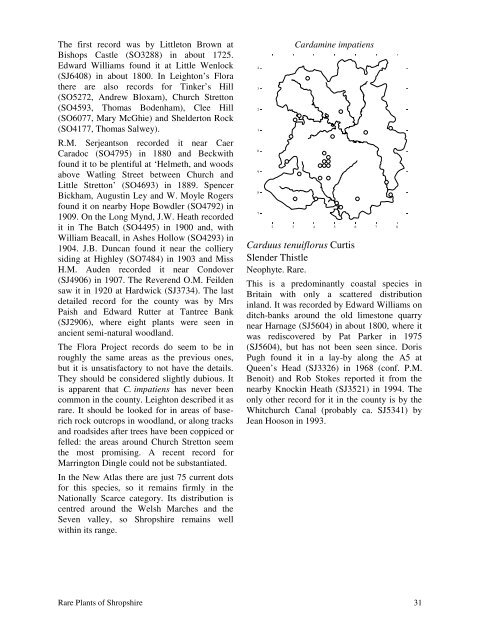Shropshire - Botanical Society of the British Isles
Shropshire - Botanical Society of the British Isles
Shropshire - Botanical Society of the British Isles
- No tags were found...
Create successful ePaper yourself
Turn your PDF publications into a flip-book with our unique Google optimized e-Paper software.
The first record was by Littleton Brown atBishops Castle (SO3288) in about 1725.Edward Williams found it at Little Wenlock(SJ6408) in about 1800. In Leighton’s Flora<strong>the</strong>re are also records for Tinker’s Hill(SO5272, Andrew Bloxam), Church Stretton(SO4593, Thomas Bodenham), Clee Hill(SO6077, Mary McGhie) and Shelderton Rock(SO4177, Thomas Salwey).R.M. Serjeantson recorded it near CaerCaradoc (SO4795) in 1880 and Beckwithfound it to be plentiful at ‘Helmeth, and woodsabove Watling Street between Church andLittle Stretton’ (SO4693) in 1889. SpencerBickham, Augustin Ley and W. Moyle Rogersfound it on nearby Hope Bowdler (SO4792) in1909. On <strong>the</strong> Long Mynd, J.W. Heath recordedit in The Batch (SO4495) in 1900 and, withWilliam Beacall, in Ashes Hollow (SO4293) in1904. J.B. Duncan found it near <strong>the</strong> collierysiding at Highley (SO7484) in 1903 and MissH.M. Auden recorded it near Condover(SJ4906) in 1907. The Reverend O.M. Feildensaw it in 1920 at Hardwick (SJ3734). The lastdetailed record for <strong>the</strong> county was by MrsPaish and Edward Rutter at Tantree Bank(SJ2906), where eight plants were seen inancient semi-natural woodland.The Flora Project records do seem to be inroughly <strong>the</strong> same areas as <strong>the</strong> previous ones,but it is unsatisfactory to not have <strong>the</strong> details.They should be considered slightly dubious. Itis apparent that C. impatiens has never beencommon in <strong>the</strong> county. Leighton described it asrare. It should be looked for in areas <strong>of</strong> baserichrock outcrops in woodland, or along tracksand roadsides after trees have been coppiced orfelled: <strong>the</strong> areas around Church Stretton seem<strong>the</strong> most promising. A recent record forMarrington Dingle could not be substantiated.In <strong>the</strong> New Atlas <strong>the</strong>re are just 75 current dotsfor this species, so it remains firmly in <strong>the</strong>Nationally Scarce category. Its distribution iscentred around <strong>the</strong> Welsh Marches and <strong>the</strong>Seven valley, so <strong>Shropshire</strong> remains wellwithin its range.43210987Cardamine impatiens2 3 4 5 6 7 8Carduus tenuiflorus CurtisSlender ThistleNeophyte. Rare.This is a predominantly coastal species inBritain with only a scattered distributioninland. It was recorded by Edward Williams onditch-banks around <strong>the</strong> old limestone quarrynear Harnage (SJ5604) in about 1800, where itwas rediscovered by Pat Parker in 1975(SJ5604), but has not been seen since. DorisPugh found it in a lay-by along <strong>the</strong> A5 atQueen’s Head (SJ3326) in 1968 (conf. P.M.Benoit) and Rob Stokes reported it from <strong>the</strong>nearby Knockin Heath (SJ3521) in 1994. Theonly o<strong>the</strong>r record for it in <strong>the</strong> county is by <strong>the</strong>Whitchurch Canal (probably ca. SJ5341) byJean Hooson in 1993.Rare Plants <strong>of</strong> <strong>Shropshire</strong> 31
















